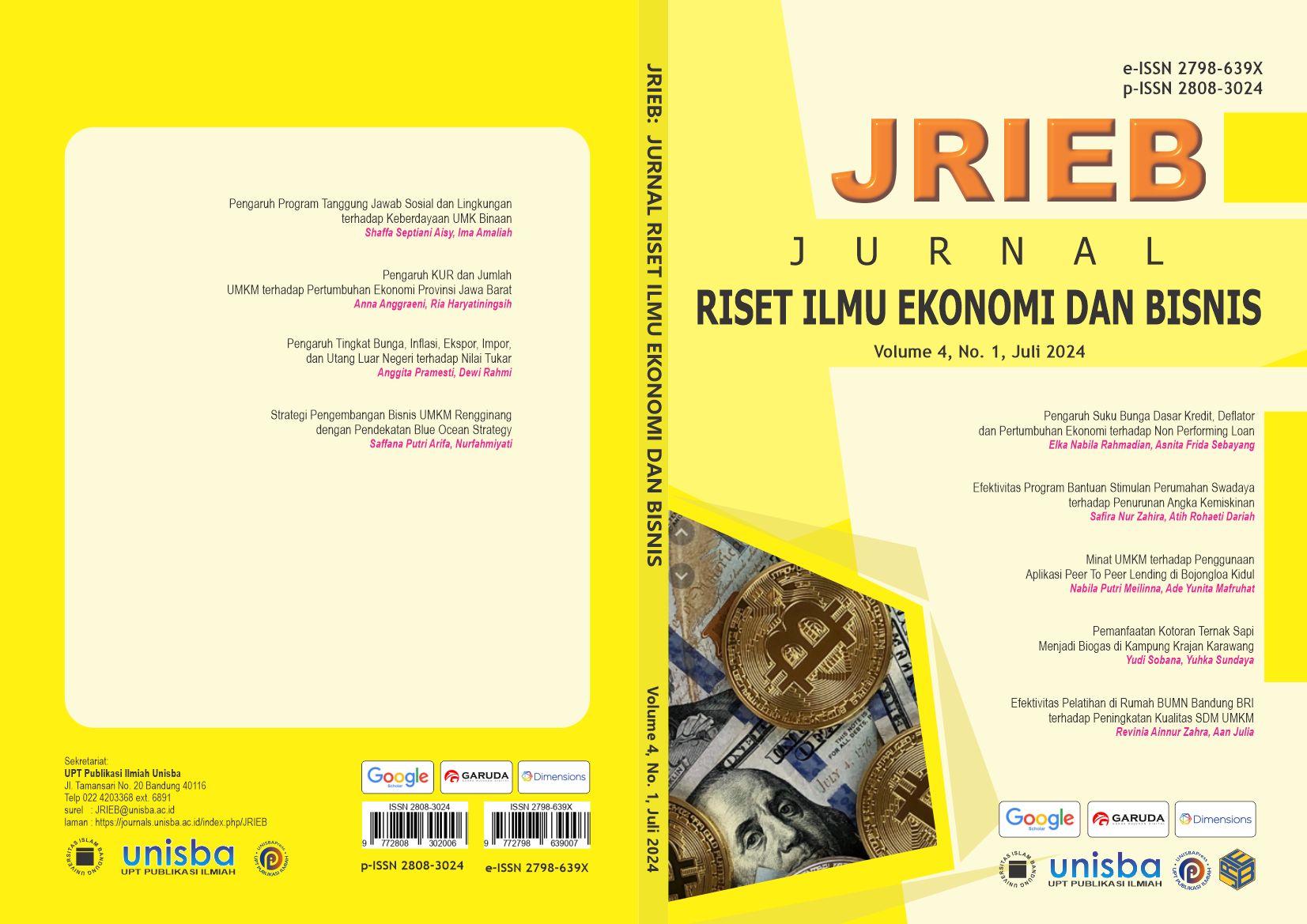Pengaruh Tingkat Bunga, Inflasi, Ekspor, Impor, dan Utang Luar Negeri terhadap Nilai Tukar
DOI:
https://doi.org/10.29313/jrieb.v4i1.3701Keywords:
nilai tukar, utang luar negeri, ECMAbstract
Abstract. In this study, interest rates, inflation rates, exports and imports, and foreign debt were converted into exchange rates (USD/IDR) from Q1 2008 to Q3 2021 to understand the factors that influence exchange rate fluctuations. This research was conducted using linear time series regression analysis with the error correction mechanism (ECM) method. Research based on the F test shows that interest rates, inflation, exports and imports, and foreign debt influence the dollar exchange rate against the rupiah in the long and short term. Results based on the t test show that inflation and imports have no effect on the dollar exchange rate against the rupiah in the short term, interest rates depreciate the dollar exchange rate against the rupiah, and exports and foreign debt increase the rupiah exchange rate against the dollar. The t test results show that in the long term, interest rates, inflation and imports do not affect the dollar exchange rate against the rupiah, while exports increase the dollar exchange rate against the rupiah, and foreign debt depresses the dollar exchange rate against the rupiah. Therefore, the government needs to regulate monetary and fiscal policies, encourage exports, manage debt, and plan exchange rate risk management.
Abstrak. Dalam studi ini, tingkat suku bunga, tingkat inflasi, ekspor dan impor, dan utang luar negeri dikonversi ke dalam nilai tukar (USD/IDR) dari Q1 2008 hingga Q3 2021 untuk memahami faktor-faktor yang mempengaruhi fluktuasi nilai tukar. Penelitian ini dilakukan dengan menggunakan analisis regresi linear time series dengan metode error Correction Mechanism (ECM). Penelitian berdasarkan uji F menunjukkan bahwa suku bunga, inflasi, ekspor dan impor, serta utang luar negeri mempengaruhi nilai tukar dolar terhadap rupiah dalam jangka panjang dan pendek. Hasil berdasarkan uji t menunjukkan bahwa inflasi dan impor tidak berpengaruh terhadap nilai tukar dolar terhadap rupiah dalam jangka pendek, suku bunga mendepresiasi nilai tukar dolar terhadap rupiah, dan ekspor dan utang luar negeri meningkatkan nilai tukar rupiah terhadap dolar. Hasil uji t menunjukkan bahwa dalam jangka panjang, suku bunga, inflasi, dan impor tidak mempengaruhi nilai tukar dolar terhadap rupiah, sedangkan ekspor meningkatkan nilai tukar dolar terhadap rupiah, dan utang luar negeri menekan nilai tukar dolar terhadap rupiah. Oleh karena itu, pemerintah perlu mengatur kebijakan moneter dan fiskal, mendorong ekspor, mengelola utang, dan merencanakan manajemen risiko nilai tukar.
References
Carissa, N., & Khoirudin, R. (2020). The factors affecting the rupiah exchange rate in Indonesia. Jurnal Ekonomi Pembangunan, 18(1), 37–46. https://doi.org/10.29259/jep.v18i1.9826
Fauji, D. A. (2016). Faktor – Faktor Yang Mempengaruhi Nilai Tukar Rupiah Periode 2013 – Triwulan I 2015 (1st ed., Vol. 1).
Mankiw, N. G. (2016). Macroeconomics (9th ed.).
Mankiw, N. G. (2018). Pengantar Ekonomi Makro (7th ed.).
Mishkin, F. S. (2017). Ekonomi Uang, Perbankan, dan Pasar Keuangan (Vol. 2).
Novi Ariani, & Ima Amaliah. (2023). Pengaruh Pertumbuhan Ekonomi, Inflasi, dan Nilai Tukar Terhadap Neraca Perdagangan Indonesia-China. Jurnal Riset Ilmu Ekonomi Dan Bisnis, 75–84. https://doi.org/10.29313/jrieb.v3i2.2882
Sabtiadi, K., & Kartikasari, D. (2018). ANALISIS PENGARUH EKSPOR IMPOR TERHADAP NILAI TUKAR USD DAN SGD. JURNAL AKUNTANSI, EKONOMI Dan MANAJEMEN BISNIS, 6(2), 135–141. https://doi.org/10.30871/jaemb.v6i2.629
Safitri, R., Sari, R. N., & Gusnardi. (2014). Analisis Aspek Fundamental dan Psikologis Terhadap Perubahan Kurs Valas di Indonesia Periode 2004 – 2012 (3rd ed., Vol. 22). unri.ac.id/index.php/JE/article/view/2608/2563.
Salvatore, D. (2014). Ekonomi Internasional (Vol. 1).
Simorangkir, I. (2014). Pengantar Kebanksentralan: Teori dan Praktik di Indonesia (1st ed.).
Sugiyono. (2011). Metode Penelitian Kuantitatif Kualitatif dan R&D. Alfabeta.
Sukirno, S. (2016). Makroekonomi Teori Pengantar (3rd ed.).













